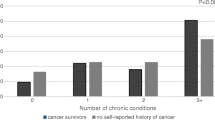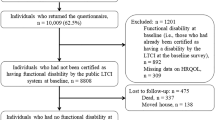Abstract
Purpose
The purpose of this study was to examine the impact of physical limitations, functional limitations and self-assessed health status on mortality and healthcare utilization among older cancer survivors.
Methods
National Medicare Current Beneficiary Survey (MCBS) cost and use data from 2008 to 2013 were used for analysis. Physical limitations, Activities of Daily Living (ADL), and Instrumental Activities of Daily Living (IADL) were assessed on multiple questions, and self-assessed health was measured on a five-point scale (1–5: Excellent–Poor). Multivariable logistic regression and Poisson regression models were used for hospitalization, re-hospitalization and mortality rates based on three follow up years.
Results
This study included 17,715 cancer patients with a mean age of 75 years and 57% females. Cancer survivors with poor self-assessed health had a higher rate of hospitalizations (adjusted Odds Ratio: aOR: 1.60, 95% Confidence Interval: CI: 1.47–1.72, p < 0.001) relative to non-cancer participants. Compared to participants with no history of cancer, cancer survivors with IADL (aOR: 1.41, 95% CI: 1.25–1.58, p < 0.001) or with poor self-assessed health (aOR: 1.39, 95% CI: 1.21–1.60, p < 0.001) were more likely to have a higher number of hospital readmissions within 30 days of a prior hospitalization. Three-year mortality rate was significantly higher among cancer survivors with poor self-assessed health (Hazard Ratio: 2.81, 95% CI: 2.81–2.82, p < 0.001).
Conclusion
Self-assessed health and physical and functional limitations significantly and independently impact healthcare utilization and mortality among older cancer survivors. Healthcare providers should incorporate formal assessments of both self-assessed health and functional status among older cancer survivors in their clinical practice.
Implication for cancer survivors
Self-reported health status is a valuable and independent predictor of healthcare utilization and mortality among cancer survivors.
Similar content being viewed by others
References
Siegel R, Miller K (2019) Cancer statistics 2019. CA Cancer J Clin 69:7–34. https://doi.org/10.3322/caac.21551
Sweeney C, Schmitz KH, Lazovich D, Virnig BA, Wallace RB, Folsom AR (2006) Functional limitations in elderly female cancer survivors. J Natl Cancer Inst 98:521–529. https://doi.org/10.1093/jnci/djj130
Mols F, Vingerhoets AJ, Coebergh JW et al (2005) Quality of life among long-term breast cancer survivors: a systematic review. Eur J Cancer 41:2613–2619
de Moor JS, Mariotto AB, Parry C et al (2013) Cancer survivors in the united states: prevalence across the survivorship trajectory and implications for care. Cancer Epidemiol Biomarkers Prevent 22:561–570. https://doi.org/10.1158/1055-9965.EPI-12-1356
Becker H, Kang SJ, Stuifbergen A (2012) Predictors of quality of life for long-term cancer survivors with preexisting disabling conditions. Oncol Nurs Forum 39:E122–E131. https://doi.org/10.1188/12.ONF.E122-E131
Parker PA, Baile WF, Moor CD et al (2003) Psychosocial and demographic predictors of quality of life in a large sample of cancer patients. Psycho-Oncol 12:183–193
Stineman MG, Streim JE, Pan Q et al (2014) Activity limitation stages empirically derived for activities of daily living (ADL) and instrumental ADL in the US adult community-dwelling medicare population. Pm&r 6:976–987. https://doi.org/10.1016/j.pmrj.2014.05.001
Katz S (1983) Assessing self-maintenance: activities of daily living, mobility, and instrumental activities of daily living. J Am Geriatr Soc 31:721–727
Stewart A, Ware Jr JE, Brook RH (1977) The meaning of health: understanding functional limitations. Med Care 15:939–952. https://www.jstor.org/stable/3763698
Field MJ, Jette A (2007) The future of disability in America. Washington D.C: National, Academies Press. Retrieved from www.nap.edu/catalog/11898.html
Jylha M (2009) What is self-rated healthand why does it predict mortality - towards a unified conceptual model. Soc Sci Med 69:307–316. https://doi.org/10.1016/j.socscimed.2009.05.013
Berger N, Heyden JV, Oyen HV (2015) The global activity limitation indicator and self-rated health: two complementary predictors of mortality. Arch Public Health 73:1–7. https://doi.org/10.1186/s13690-015-0073-0
Wolinsky FD, Bentler SE, Hockenberry J et al (2011) Long-term declines in ADLs, IADLs, and mobility among older medicare beneficiaries. BMC Geriatrics 11:43-2318-11-43. https://doi.org/10.1186/1471-2318-11-43
Franks P, Gold M, Fiscella K (2003) Sociodemographics, self-rated health, and mortality in the US. Soc Sci Med 56:2505–2514
Latkin C, Edwards C, Davey-Rothwell M et al (2017) The relationship between social desirability bias and self-reports of health, substance use, and social network factors among urban substance users in baltimore, maryland. Addict Behav 73:133–136. https://doi.org/10.1016/j.addbeh.2017.05.005
Vaillant N, Wolff F (2012) On the reliability of self-reported health: evidence from Albanian data. J Epidemiol Glob Health 2:83–98. https://doi.org/10.1016/j.jegh.2012.04.003
Chavan P, Kedia S, Yu X (2019) Impact of physical and functional limitations on health care utilization in older cancer survivors: a medicare current beneficiary survey. J Aging Health. https://doi.org/10.1177/0898264319872309
Alam M (2006) Ageing in India: socioeconomic and health dimensions. Academic Foundation, New Delhi
Saeed B, Oduro S, Ebenezer A, Zhao X (2012) Determinants of healthcare utilization among the ageing population in ghana. Int J Bus Soc Sci 3:66–77
Medicare current beneficiary survey (MCBS) (2016) Retrieved from https://www.cms.gov/Research-Statistics-Data-and-Systems/Files-for-Order/LimitedDataSets/MCBS.html
National Cancer Institute (2015) Retrieved from https://www.cancer.gov/publications/dictionaries/cancer-terms?cdrid=450125
Romano PS, Roos LL, Jollis JG (1993) Presentation adapting a clinical comorbidity index for use with ICD-9-CM administrative data: differing perspectives. J Clin Epidemiol 46:1075–1079
Husain Z, Ghosh S (2011) Is health status of elderly worsening in india? acomparison of successive rounds of national sampe survey data. J Biosoc Sci 43:211–231. https://doi.org/10.1017/S0021932010000623
Idler E, Russell L, Davis D (2000) Survival, functional limitations, and self-rated health in the NHANES I epidemiologic follow-up study, 1992. Am J Epidemiol 152:874–883. https://doi.org/10.1093/aje/152.9.874
Lee Y (2000) The predictive value of self-assessed general, physical, and mental health on functional decline and mortality in older adults. J Epidemiol Community Health 54:123–129
DeSalvo K, Fan V, McDonell M, Fihn S (2005) Predicting mortality and healthcare utilization with a single question. Health Serv Res 40:1234–1246. https://doi.org/10.1111/j.1475-6773.2005.00404.x
Schousboe J, Vo T, Kats A, Langsetmo L, Diem S, Taylor B, Ensrud K (2019) Depressive symptoms and total healthcare costs: roles of functional limitations and multimorbidity. J Am Geriatric Soc. https://doi.org/10.1111/jgs.15881
Krumpal I (2013) Determinants of social desirability bias in sensitive surveys: a literature review. Qual Quant 47:2025–2047. https://doi.org/10.1007/s11135-011-9640-9
Jones S, Chennupati S, Nguyen T, Fedorenko C, Ramsey S (2019) Comorbidity is associated with higher risk of financial burden in medicare beneficiaries with cancer but not heart disease or diabetes. Medicine 98:e14004. https://doi.org/10.1097/MD.0000000000014004
Kedia S, Chavan P, Boop S, Yu X (2017) Health care utilization among elderly medicare beneficiaries with coexisting dementia and cancer. Gerontol Geriatr Med 3:1–9. https://doi.org/10.1177/2333721416689042
Chavan P, Kedia S, Yu X (2017) Physical and functional limitations in US older cancer survivors. J Palliative Care Med. https://doi.org/10.4172/2165-7386.1000312
McCabe M, Bhatia S, Oeffinger K et al (2013) American society of clinical oncology statement: achieving high-quality cancer survivorship care. J Clin Oncol 31:631–640. https://doi.org/10.1200/JCO.2012.46.6854
Howlader N, Noone A, Krapcho M et al (2015) SEER cancer statistics review, 1975–2012, National Cancer Institute. Bethesda, MD. based on November 2014 SEER data submission, posted to the SEER web site, April 2015. Retrieved from http://seer.cancer.gov/csr/1975_2012
Author information
Authors and Affiliations
Corresponding author
Ethics declarations
Conflict of interest
All authors declared no conflict of interest in this study. This study was partially funded by the faculty research seed grant from the University of Memphis. The funder has no role in conducting, interpreting, and reporting the study.
Ethics approval
This study was performed using the secondary data purchased from the Center for Medicare and Medicaid Services, and was approved by the Institute Review Board at the University of Memphis. The data were considered limited use of data and contained no personal identifiable information. Since there were no human subjects directly involved in this study, no inform consent was needed.
Human and animal rights
This article does not contain any studies with human participants or animals performed by any of the authors.
Informed consent
For this type of study, formal consent is not required.
Additional information
Publisher's Note
Springer Nature remains neutral with regard to jurisdictional claims in published maps and institutional affiliations.
Electronic supplementary material
Below is the link to the electronic supplementary material.
Rights and permissions
About this article
Cite this article
Chavan, P.P., Kedia, S.K., Mzayek, F. et al. Impact of self-assessed health status and physical and functional limitations on healthcare utilization and mortality among older cancer survivors in US. Aging Clin Exp Res 33, 1539–1547 (2021). https://doi.org/10.1007/s40520-020-01654-5
Received:
Accepted:
Published:
Issue Date:
DOI: https://doi.org/10.1007/s40520-020-01654-5




